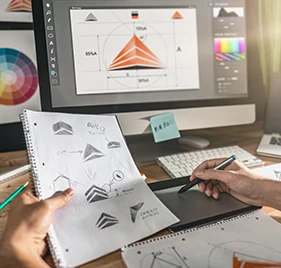As the world becomes increasingly digitized, it's important for graphic designers to consider the environmental impact of their work. This article explores the concept of eco-aesthetics, or how graphic design can be used to communicate environmental messages. It discusses the use of green design principles, sustainable materials, and recycled content in the creation of eco-friendly graphic design.
What is eco-aesthetics?
Eco-aesthetics is a term used to describe the relationship between art and the environment. It is based on the idea that the environment is a source of inspiration for artists and that art can be used to raise awareness of environmental issues. Eco-aesthetics is also concerned with the impact of art on the environment. For example, some artists use recycled materials in their work or create artworks that raise awareness of environmental issues.
How can graphic design go green?
As the world becomes increasingly aware of the need to protect the environment, many businesses are looking for ways to "go green." Graphic design is no exception. There are many ways that graphic designers can help to make a business more environmentally friendly.
One way to make graphic design more environmentally friendly is to use recycled materials. Many graphic designers use paper and other materials that can be easily recycled. Using recycled materials not only reduces waste, but it can also be cost effective.
Another way to make graphic design more environmentally friendly is to use digital technology. By using computers and other digital devices, graphic designers can save paper and other resources. In addition, digital technology can help to reduce the carbon footprint of a business.
There are many other ways that graphic designers can help to make a business more environmentally friendly. By using eco-friendly materials and technologies, graphic designers can help to make a difference.
What are some benefits of eco-aesthetics?
Eco-aesthetics is a term that is used to describe the environmentally friendly aspects of graphic design. This can include using recycled materials, using eco-friendly inks and dyes, and using sustainable design practices. Eco-aesthetics can also refer to the overall look and feel of a design that is meant to be environmentally friendly.
There are many benefits of eco-aesthetics in graphic design. One of the most obvious benefits is that it helps to protect the environment. By using recycled materials and eco-friendly inks and dyes, designers can help to reduce the amount of pollution and waste that is produced each year. Additionally, sustainable design practices can help to reduce the amount of energy and resources that are used in the production of a design.
Another benefit of eco-aesthetics is that it can help to create a more positive image for a company or organization. Companies that are seen as being environmentally friendly are often perceived in a more positive light by the public. This can lead to increased sales and profits. Additionally, eco-friendly designs can help to attract new customers and clients.
Finally, eco-aesthetics can also help to improve the quality of a design. By using sustainable practices, designers can create designs that are more durable and longer lasting. This can save money in the long run, as well as help to reduce the amount of waste that is produced.
Overall, there are many benefits of eco-aesthetics in graphic design. These benefits can help to protect the environment, improve the quality of a design, and create a more positive image for a company or organization.
Are there any drawbacks to eco-aesthetics?
Eco-aesthetics is a new trend in graphic design that focuses on making designs that are environmentally friendly. There are many benefits to eco-aesthetics, such as helping to reduce the amount of paper and ink used, and making designs that are more recyclable. However, there are some drawbacks to eco-aesthetics as well. One drawback is that eco-friendly designs can sometimes be more expensive to produce. Another drawback is that it can be difficult to find eco-friendly materials that meet all of the design criteria.
